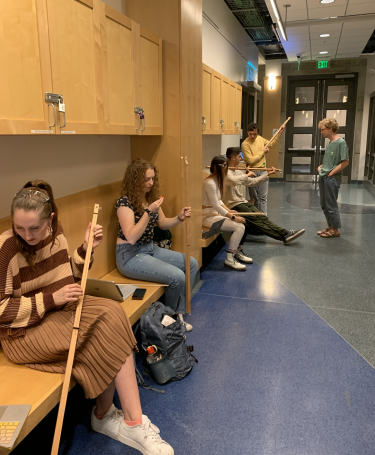Instrument Design Lab explores the science of music | College of Music

 For Annika Socolofsky, the realms of artwork and science aren’t mutually distinctive.
For Annika Socolofsky, the realms of artwork and science aren’t mutually distinctive.
Socolofsky, assistant professor of composition and school coach for CU Boulder SoundWorks, has strong footing in the two worlds. She’s an attained composer, vocalist and musical pedagogue, and she also boasts a lengthy educational resume as a scholar of science.
She weds these two sides of her individuality in Instrument Style Lab (IDL), a class developed to give Higher education of Tunes college students a foundation in the science of music as they go after their inventive muse. Centered on a very similar class that was developed by Socolofsky’s graduate advisor Dan Trueman at Princeton College, the IDL class introduced in the slide of 2022 and delivers a science-primarily based context to instrumentation, seem and musical development.
“The system goal for IDL is for learners to much better comprehend how the physics of seem, tuning and temperament, resonance and performance all interact in our willpower,” states Socolofsky, who was preceptor for the class at Princeton. “We operate to attain this comprehension as a result of the constructing and building of new acoustic instruments.”
Specifically, that’s translated into a extensive array of finding out activities, which include constructing stringed devices from scratch, a course action that allows learners to see exactly what goes into the physics of new music. Getting a standpoint into every section of the creation of an instrument can be revelatory for pupils, even for all those who’ve been participating in music due to the fact childhood.
 The course also explores the scientific components of the human voice in approaches that are engaging and enjoyment. For case in point, Socolofsky speaks about breaking down recordings of Dolly Parton’s tune “Shinola,” and digging into the deeper scientific implications of her efficiency.
The course also explores the scientific components of the human voice in approaches that are engaging and enjoyment. For case in point, Socolofsky speaks about breaking down recordings of Dolly Parton’s tune “Shinola,” and digging into the deeper scientific implications of her efficiency.
“Students compared the resonances of various vocal procedures Parton works by using in the song,” Socolofsky suggests. “They employed their mathematical results to more why Parton selected to use many vocal techniques—head voice, chest voice, aspirated attributes and false vocal folds—to deepen the this means of the textual content in the tune.”
The class culminates in remaining jobs that see pupils conducting in-depth exploration, or coming up with and developing their possess devices. The prompt spurred progressive innovations from learners, which includes novel usually takes on harps, flutes and even Japanese swords.
“Student innovations involved a multi-flute—flute able of executing several notes simultaneously—by Rain Michael, a “bassoon-a-loon”—a wind instrument that used vibrating balloon membranes to make audio in the method of a double reed—by Robert Scherer, and a harp with many resonating bodies of several styles and components by Jessie Lausé,” Socolofsky remembers. “A ultimate undertaking experiment by Reina Krumvieda was an examination of the Aeolian tones, or ‘tachikaze,’ that Japanese swords make as they are swung through the air at distinct speeds.”
All of these initiatives harnessed the fundamentals of physics, audio assessment and primary science to support college students see musical creativity in new means. For budding musicians looking to just take their artwork to new and enjoyable areas, it’s an technique that is sure to spend off in all realms of composition and efficiency.



